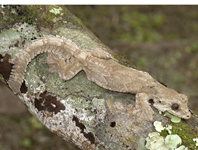Abstract
Eniacomorpha hermetiae Delvare sp. n. (Hymenoptera, Chalcididae, Dirhininae), reared from pupae of black soldier fly (BSF), Hermetia illucens (Linnaeus, 1758) (Diptera, Stratiomyidae), is described and illustrated from Africa and compared with other similar species newly considered as forming the ehrhorni species-group within Eniacomorpha Girault, 1915. The newly described parasitic wasp may have a negative impact on efforts to mass produce BSF in Africa as a feed supplement for domestic animals. Eniacomorpha is removed from synonymy under Dirhinus Dalman, 1818, revised status, for the Afrotropical species of Dirhininae previously placed in Dirhinus subgenus Pareniaca Crawford, 1913. A checklist of the 10 recognized species of Afrotropical Eniacomorpha is given, of which 9 are new generic combinations.
References
Banks, I.J., Gibson, W.T. & Cameron, M.M. (2014) Growth rates of black soldier fly larvae fed on fresh human faeces and their implication for improving sanitation. Tropical Medicine and International Health, 19, 14–22.
https://doi.org/10.1111/tmi.12228
Bouček, Z. (1992) The New World genera of Chalcididae. In: Delvare, G. & Bouček, Z. (Eds.), On the World Chalcididae (Hymenoptera). Memoirs of the American Entomological Institute, 53, pp. 49–117.
Bouček, Z. & Narendran, T.C. (1981) Indian chalcid wasps (Hymenoptera) of the genus Dirhinus parasitic on synanthropic and other Diptera. Systematic Entomology, 6, 229–251.
https://doi.org/10.1111/j.1365-3113.1981.tb00438.x
Bradley, S.W., Booth, D.C. & Sheppard, D.C. (1984) Parasitism of the Black Soldier Fly by Trichopria sp. (Hymenoptera: Diapriidae) in poultry houses. Environmental Entomology, 13, 451–454.
https://doi.org/10.1093/ee/13.2.451
Branstetter, M.G., Danforth, B., Pitts, J.P., Faircloth, B.C., Ward, P.S., Buffington, M.L., Gates, M.W., Kula, R.R. & Brady, S.G. (2017) Phylogenomic insights into the evolution of stinging wasps and the origins of ants and bees. Current Biology, 27, 1019–1025.
https://doi.org/10.1016/j.cub.2017.03.027
Chiel, E. & Kuslitzky, W. (2015) Diversity and abundance of house fly pupal parasitoids in Israel, with first records of two Spalangia species. Environmental Entomology, 45 (2), 283–291.
https://doi.org/10.1093/ee/nvv180
Choi, Y.C., Choi, J.Y., Kim, J.G., Kim, M.S., Kim, W.T., Park, K.H., Bae, S.W. & Jeong, G.S. (2009) Potential usage of food waste as a natural fertilizer after digestion by Hermetia illucens (Diptera: Stratiomyidae). International Journal of Industrial E https://doi.org/10.1093/ee/13.2.451ntomology, 19, 171–174.
Crawford, J.C. (1913) Descriptions of new Hymenoptera. No 7. Proceedings of the United States National Museum, 45, 309–317.
https://doi.org/10.5479/si.00963801.45-1984.309
Cruaud A., Delvare, G., Nidelet, N., Sauné, L., Ratnasingham, S., Chartois, M., Blaimer, B., Gates, M., Brady, S., Faure, S., van Noort, S., Rossi, J.P. & Rasplus J.-Y. (2019) Resolving the tree of life of poorly known groups: Exploration of phylogenomic incongruence in chalcid wasps (Hymenoptera: Chalcidoidea: Chalcididae). Systematic Biology. [submitted]
Čičková, H., Newton, G.L., Lacy, R.C. & Kozánek, M. (2015) The use of fly larvae for organic waste treatment. Waste Management, 35, 68–80.
https://doi.org/10.1016/j.wasman.2014.09.026
Delvare, G. & Copeland, R.S. (2018) Four-horned wasps, description of some remarkable Dirhinus Hymenoptera, Chalcididae) from Kenya, with a discussion of their taxonomic placement. Zootaxa, 4374 (3), 301–349.
https://doi.org/10.11646/zootaxa.4374.3.1
Delvare, G., Cruaud, A., Nidelet, S., Sauné, L. & Rasplus, J.-Y. (2019) Ultra-Conserved Elements and morphology provide congruent evidence for a new generic classification of the Chalcididae (Hymenoptera, Chalcidoidea). Systematic Entomology. [in preparation]
Devic, E. & Maquart, P.-O. (2015) Dirhinus giffardii (Hymenoptera Chalcididae), parasitoid affecting Black Soldier Fly production systems in West Africa. Entomologia, 3 (284), 25–27.
https://doi.org/10.4081/entomologia.2015.284
Girault, A.A. (1915) Australian Hymenoptera Chalcidoidea—XIV. The family Chalcididae with descriptions of new genera and species. Memoirs of the Queensland Museum, 4, 314–365.
Green, T.R. & Popa, R. (2012) Enhanced ammonia content in compost leachate processed by black soldier fly larvae. Applied Biochemistry and Biotechnology, 166, 1381–1387.
https://doi.org/10.1007/s12010-011-9530-6
Kim, W., Bae, S., Park, K., Lee, S., Choi, Y., Han, S. & Koh, Y. (2011) Biochemical characterization of digestive enzymes in the black soldier fly, Hermetia illucens (Diptera: Stratiomyidae). Journal of Asia-Pacific Entomology, 14, 11–14.
https://doi.org/10.1016/j.aspen.2010.11.003
Lalander, C., Diener, S., Magri, M.E., Zurbrugg, C., Lindstrom, A. & Vinneras, B. (2013) Faecal sludge management with the larvae of the black soldier fly (Hermetia illucens)—From a hygiene aspect. Science of the Total Environment, 458, 312–318.
https://doi.org/10.1016/j.scitotenv.2013.04.033
Masi, L. (1947) Nuovo contributo all conoscenza dei Dirhinini (Hymen. Chalc.). Eos, Revista Española di Entomologia, Madrid, 23, 39–78.
Nguyen, T.T.X., Tomberlin, J.K. & Vanlaerhoven, S. (2015) Ability of black soldier fly (Diptera: Stratiomyidae) larvae to recycle food waste. Environmental Entomology, 44, 406–410.
https://doi.org/10.1093/ee/nvv002
Risbec, J. (1957) Hyménoptères Proctotrupidae et Chalcidoidea. Mémoires de l'Institut Scientifique de Madagascar, Série E, 8, 321–366.
Schmitz, G. (1946) Chalcididae (Hymenoptera Chalcidoidea). In: Exploration du Parc National Albert, Mission G. F. de Witte (1933-1935). Fascicule 48. Institut des Parcs Nationaux du Congo Belge, Bruxelles, pp. 1–191, 17 pls.
Sheppard, C. (1983) Housefly and lesser fly control utilizing the black soldier fly in manure management-systems for caged laying hens. Environmental Entomology, 12, 1439–1442.
https://doi.org/10.1093/ee/12.5.1439
Sheppard, D.C., Tomberlin, J.K., Joyce, J.A., Kiser, B.C. & Sumner, S.M. (2002) Rearing methods for the black soldier fly (Diptera: Stratiomyidae). Journal of Medical Entomology, 39, 695–698.
https://doi.org/10.1603/0022-2585-39.4.695
Silvestri, F. (1913) Viaggio in Africa per cercare parassiti di mosche dei frutti. Bollettino del Laboratorio di Zoologia Generale e Agraria della R. Scuola Superiore d’Agricoltura, Portici, 8, 1–164.
Wang, X.-G. & Messing, R.H. (2004) Potential interactions between and egg- or larval-pupal parasitoids of tephritid fruit flies. Environmental Entomology, 33 (5), 1313–1320.
https://doi.org/10.1603/0046-225X-33.5.1313
Waterston, J. (1917) Chalcidoidea bred from Glossina in the northern territories, Gold Coast. Bulletin of Entomological Research, 8, 178–179.
https://doi.org/10.1017/S0007485300037585
Webster, C.D., Rawles, S.D., Koch, J.F., Thompson, K.R., Kobayashi, Y., Gannam, A.L., Twibell, R.G. & Hyde, N.M. (2016) Bio-ag reutilization of distiller’s dried grains with solubles (DDGS) as a substrate for black soldier fly larvae, Hermetia illucens, along with poultry by-product meal and soybean meal, as total replacement of fish meal in diets for nile tilapia, Oreochromis niloticus. Aquaculture Nutrition, 22, 976–988.
https://doi.org/10.1111/anu.12316
Yu, G.H., Chen, Y.H., Yu, Z.N. & Cheng, P. (2009) Research progress on the larvae and prepupae of black soldier fly Hermetia illucens used as animal feedstuff. Chinese Bulletin of Entomology, 46, 41–45.
Zheng, L.Y., Hou, Y.F., Li, W., Yang, S., Li, Q. & Yu, Z.N. (2012) Biodiesel production from rice straw and restaurant waste employing black soldier fly assisted by microbes. Energy, 47, 225–229.
https://doi.org/10.1016/j.energy.2012.09.006

